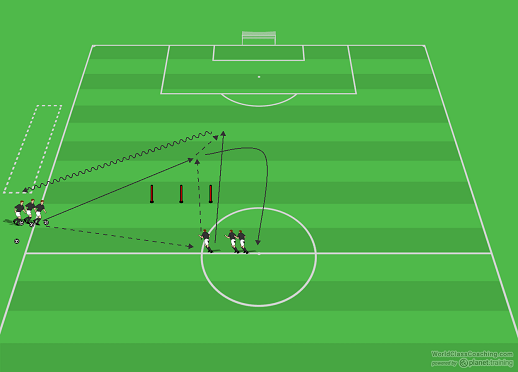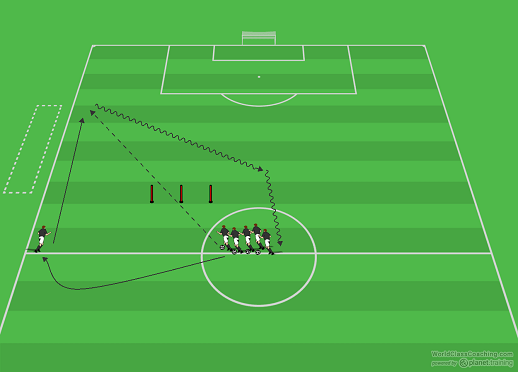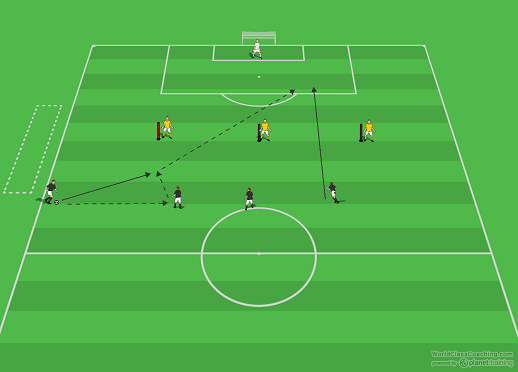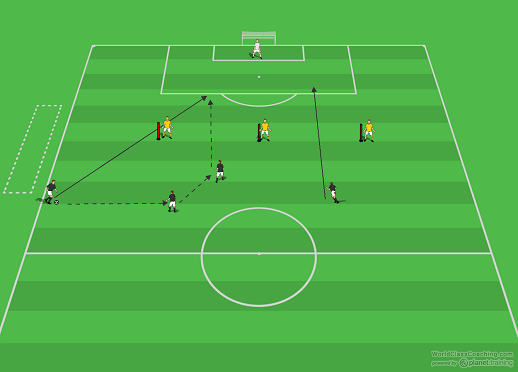By Mike Smith
One of the simple constants I have found with teams who “know” each other well is how the runs and the passes always seem to match. Sometimes this takes years to develop, especially in congested areas like a tight midfield or a packed box. One of the tools I have found which helps make this cohesiveness work, even for newer or younger teams, is the idea of the straight ball / angled run or the angled ball / straight run. This is great for making through balls work. IF the passer is in the position to make a straight pass, the runner should attack at an angle. Vice versa for if the passer has an open angled pass. It sounds really simple but often times chances are missed in just this way in games. A good session clarifying this idea could be the difference in creating a chance or losing one.
Lesson 1
Straight Ball / Angled Run
Set Up
Set up 3 posts to simulate lanes between attackers to one side of the field near the top of the center circle as shown. At the touch line, one player serves the ball into a player at the intersection of the center circle and half line. The player receiving the ball hits a pass through the lane as the first player angles a run to receive it. When the first player receives the through pass, they touch it forward to the passing player who has continued a run and the players switch positions as the next two players repeat.

As shown on the next diagram, once the players have gotten this down, play is switched to the angled ball / straight run idea. For this, the majority of the players are at the center circle, each with a ball, and they simply make a well hit angled ball up the sideline to an attacker running straight up the line. The players running up the line receives the ball and dribbles back to the passing line while the passer goes out to the line to become the runner.

Coaching Points
Accurate passes well hit through the lanes are key here, and I always find myself surprised at how good of a job defending the stationary red posts can do.
Lesson 2
Add Some Pressure
Set Up
Back off the three red posts to mark the top of the attacking third and place a defender on each as shown. A group of 4 attackers starts at the top of the circle, with the wide player starting with the ball. In the first progression, the wide player sends a ball into a central player, who plays him slightly forward to set up the angled through ball to the other wide attacker who is running straight through the gap. At this stage, defenders stay on their posts and only clear balls which come right to them. Attackers may shoot once receiving the through pass, but there is a 2 touch limit.

The next progression sees the wide player send the initial pass in as before, but now the central receiving player combines with the other central player to send a straight ball in to the starting player, who has made an angled attacking run in.

Coaching Points
Accuracy and timing of passes, that’s what this is all about. Once the players have it down, the coach can release the players from their posts as the initial pass is made. This will force the attackers to communicate and make the best choice of passes. It is the wide players job to read what the passers have and adjust their runs accordingly. As the activity progresses it can easily become a 6 defender vs 8 attacker drill with allowable goals coming only from through balls on the ground.
By Mike Smith
Currently the Head Coach for University Heights Academy Boys Soccer in Hopkinsville, KY , Mike is in his 14th year as a high school head coach with 23 years coaching experience overall and 34 year as a student and fan of the game. He holds a USSF D License.


